————————————————————————————————-
-
Types
of word combinations. Classifications of word-groups. -
Free
word groups. -
Phraseology
as a subsystem of language. -
A
phraseological unit. -
Distinction
between free word-groups and phraseological
units. -
Classification
of phraseological units. -
Sources
of phraseological units.
————————————————————————————————-
1. Types of word combinations. Classifications of word-groups
The
vocabulary of any language consists not only of words but also of
different word groups and expressions.
Words put together to form lexical units make phrases or word-groups.
A word-combination (word-group) is a combination of two or more
words organizes according to the norms of the language. There are
three types of word-groups: 1) free; 2) semi-free (устойчивые);
3) phraseological units.
They are
different structurally and semantically.
2. Free word groups
Free
word combinations
are structurally and semantically unstable, e.g. a
good man;
a
good and reliable man;
a better man,
a
good woman.
They are characterized by the following features:
-
They are
made up by the speaker; they are productive. -
Each word
in a free word combination realizes its own meaning. For example, in
the word-combination a
red rose,
to
write a letter,
extremely
dangerous,
each word has its own meaning, and the meaning of the whole phrase
is the sum of the meanings of its components. -
Substitution
is possible in them.
to walk
fast
to
walk
slowly to move fast
forward
to run
backward
to go
in
the park to drive
in
the forest to fly
Semi-free
or
Fixed
combinations
of
words are
structurally and semantically stable and the meaning is understood
from the meanings of the components. That means there is no
transference of meaning of these combinations, e.g. a
man of business;
a
man of letters
(писатель).
They stand midway between free word-combinations and phrasiological
units. They are characterized in the following way:
-
They are
fixed because they are not made up in speech but are used as
ready-made units. -
The
meaning of the whole can be inferred from the meanings of its
components. -
They are
transitional, semi-productive.
Examples:
soft
landing,
to
commit suicide,
good
luck,
black
coffee,
Merry
Christmas,
Good
afternoon.
3. Phraseology as a subsystem of language
Phraseology
is
a branch of lexicology which studies different types of fixed
expressions, which like words name various objects and phenomena.
They are not created by the speaker but exist in the language as
ready-made units. These word-groups are characterized by stability of
structure and transferred (перенос)
meaning (take
the bull by the horn
–действовать
решительно,
напрямик
= брать
быка
за
рога);
(to
burn one’s boats –
совершать
решительный
поступок,
бесповоротно
разрывая
с
прошлым
= сжечь
корабли);
(to
eat a bushel of salt with –
очень
долгое
время
общаясь,
хорошо
узнать
кого-либо
= съесть
пуд
соли).
Соседние файлы в предмете [НЕСОРТИРОВАННОЕ]
- #
- #
- #
- #
30.04.2022451 Кб2Учебник 213.docx
- #
- #
- #
- #
- #
- #
- #
- Размер: 211 Кб
- Количество слайдов: 39
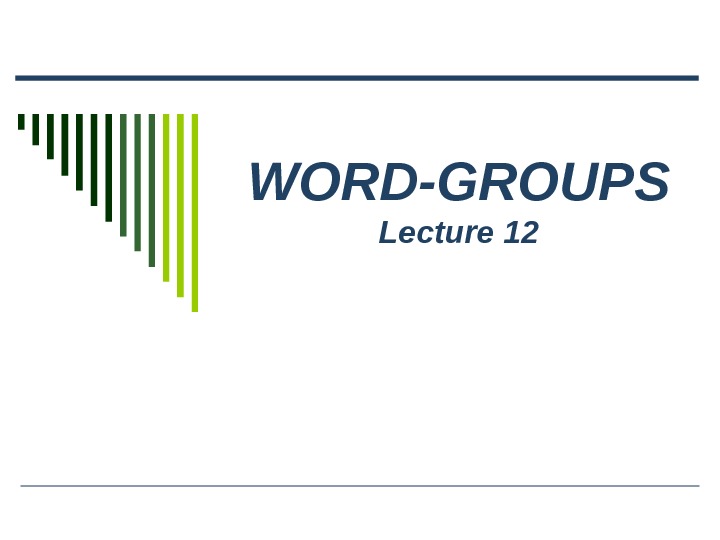
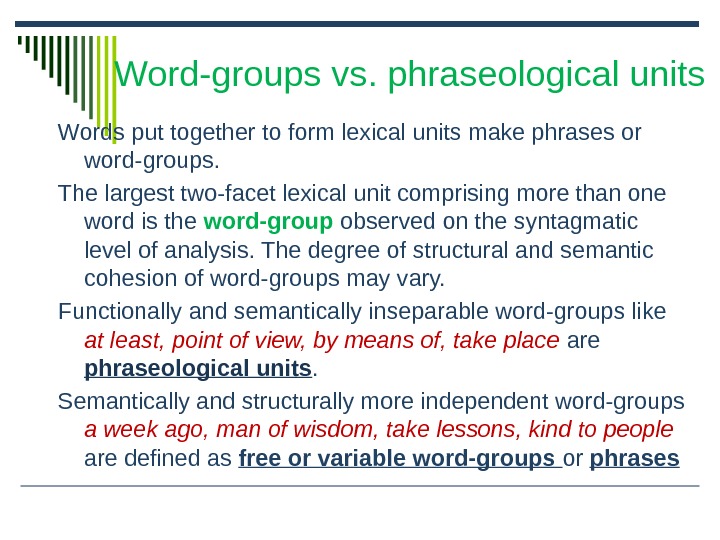
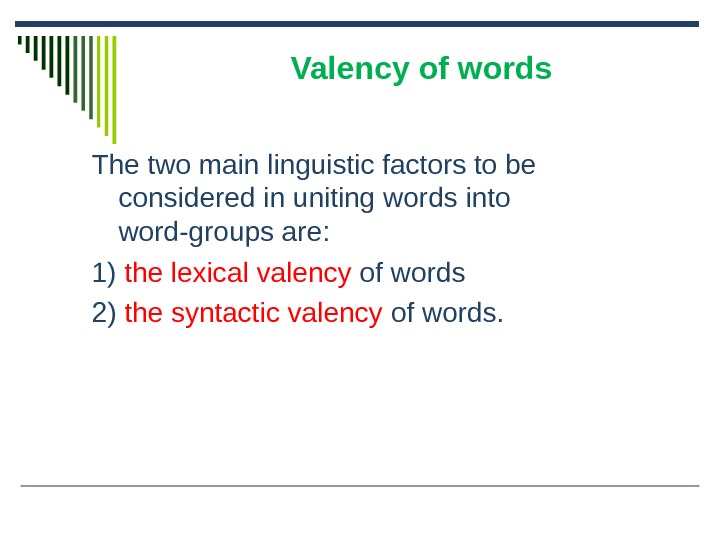
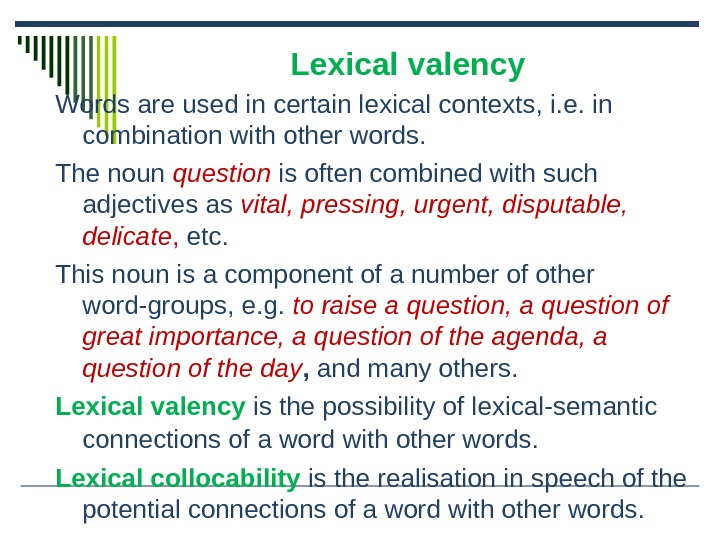
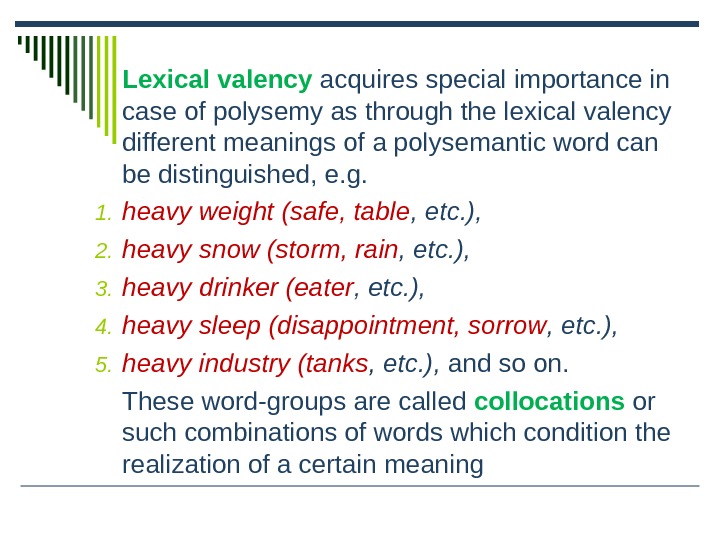
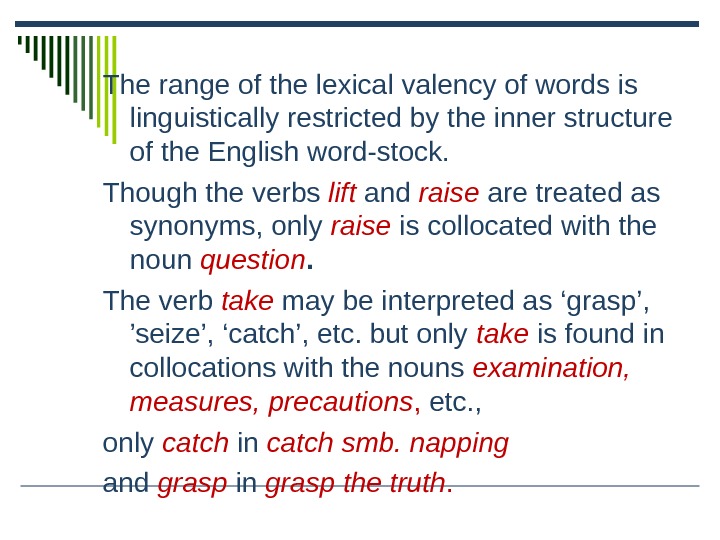


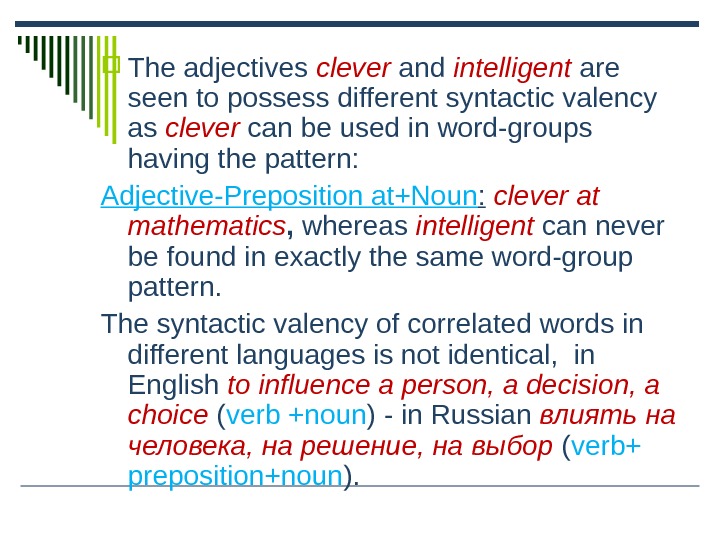

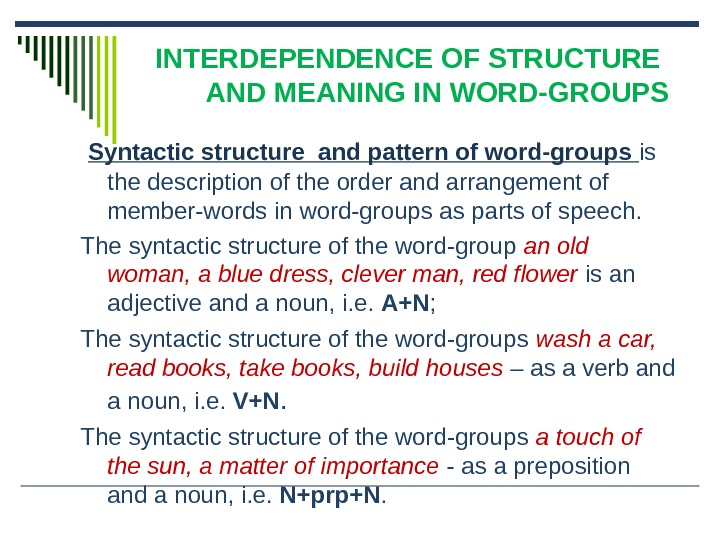

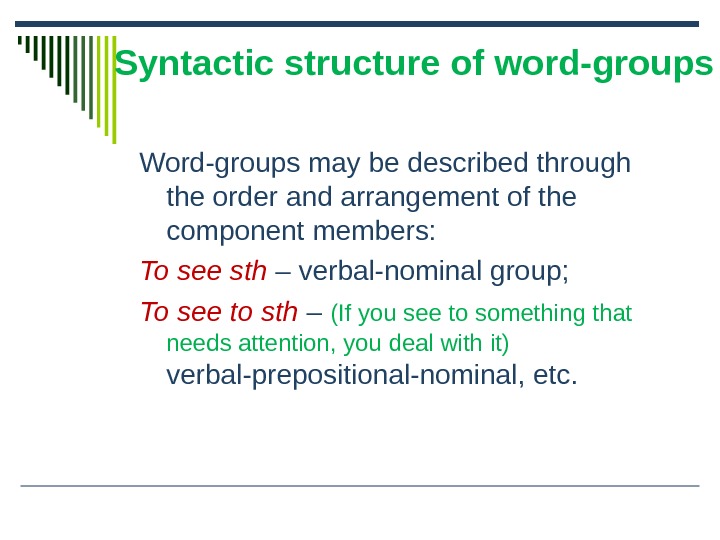

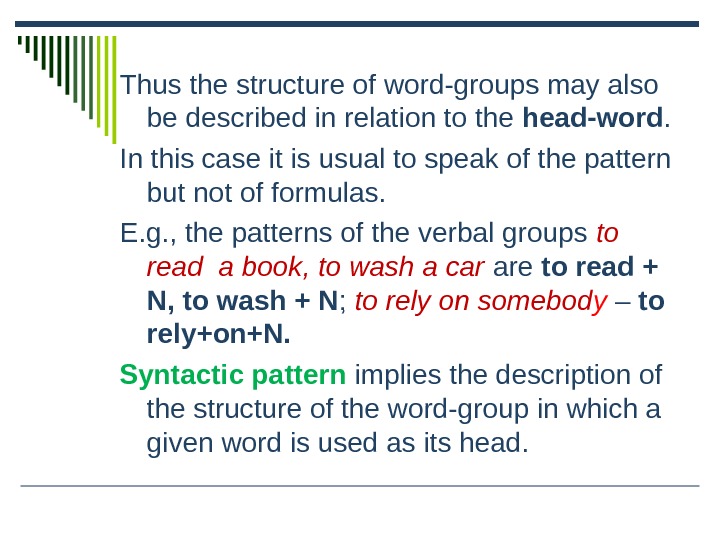

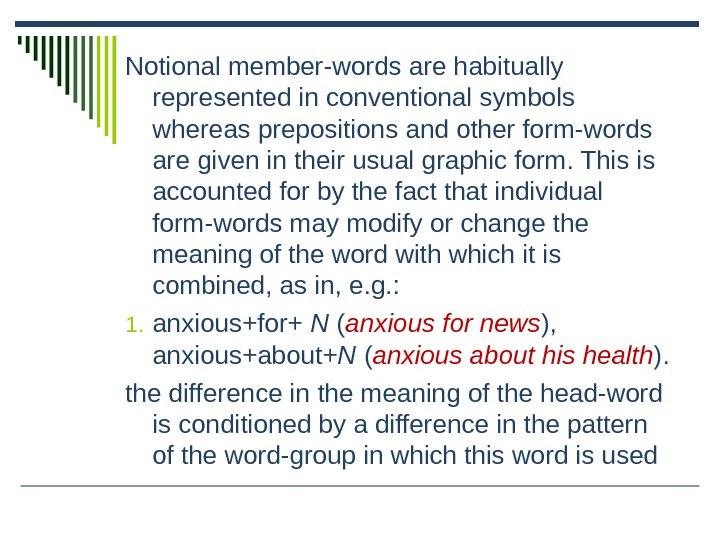
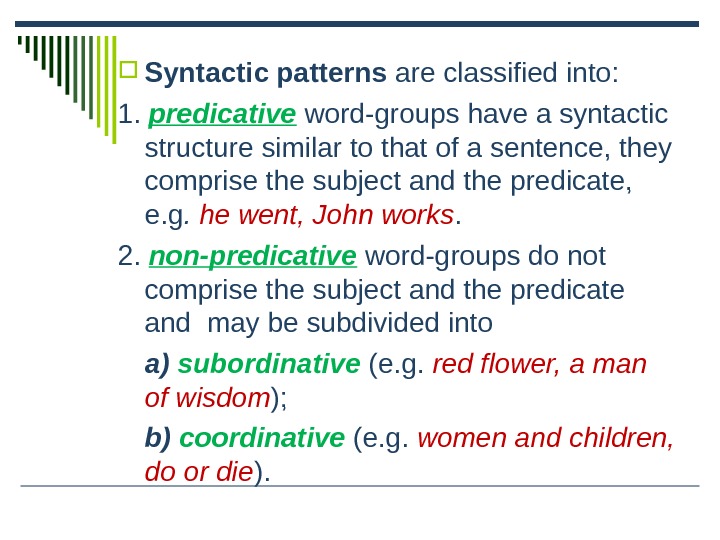
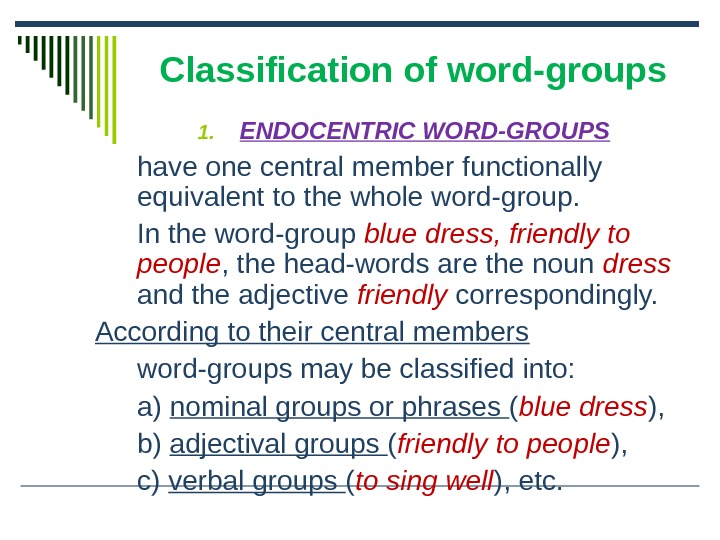
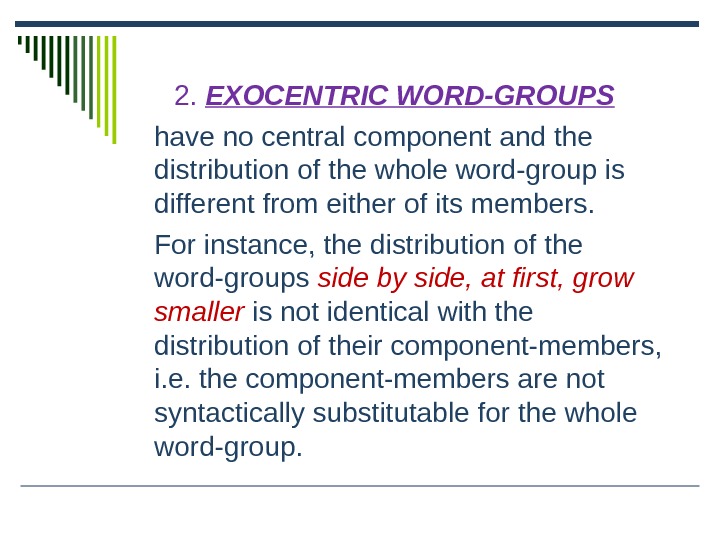

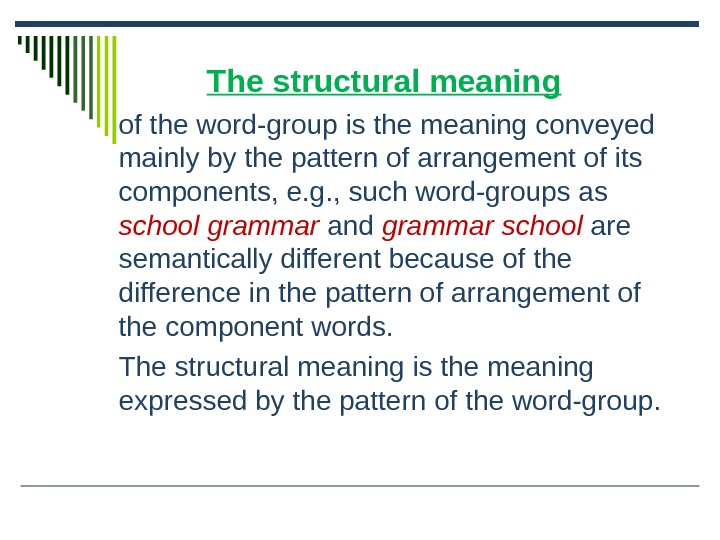
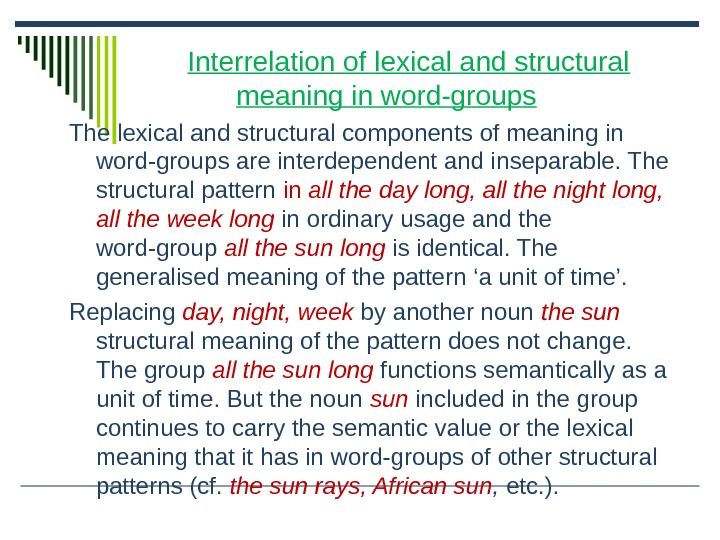

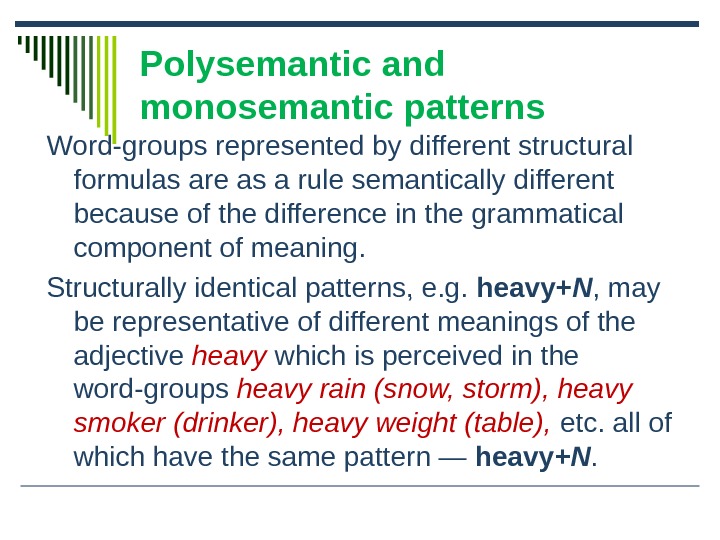


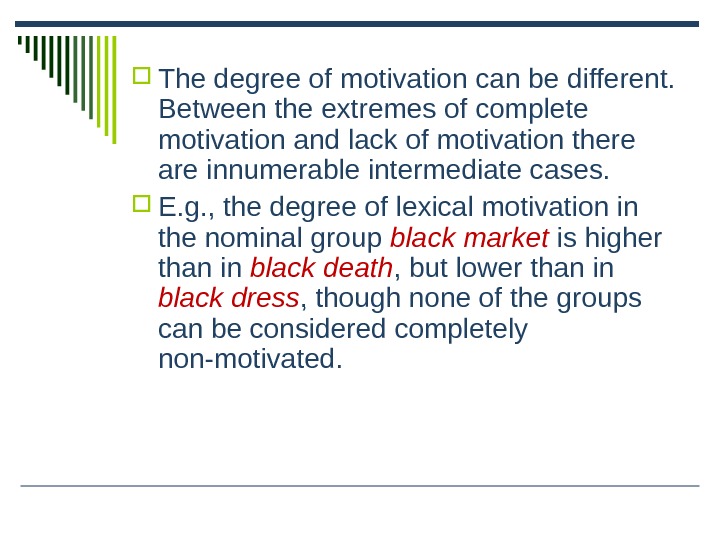

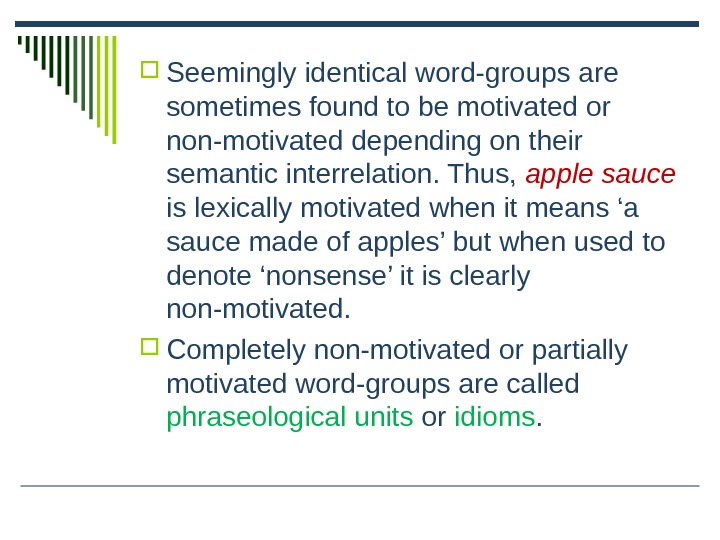
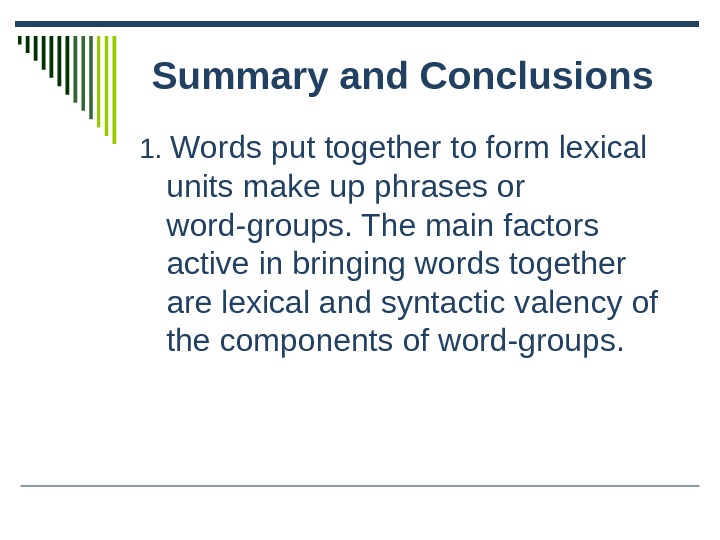
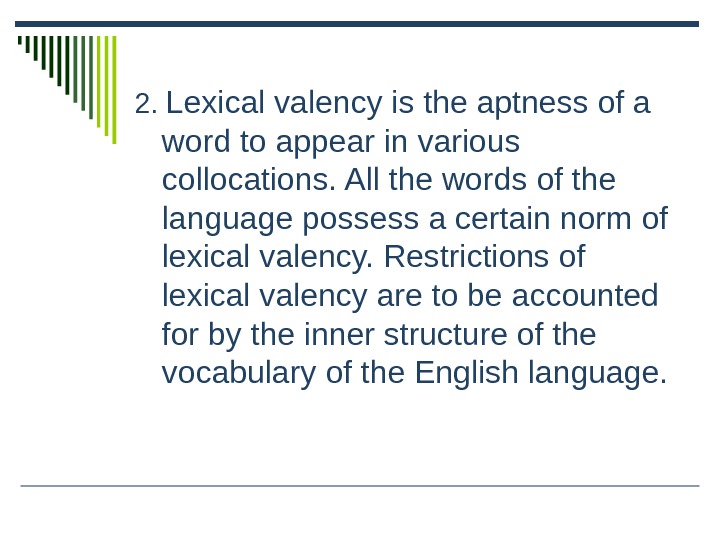

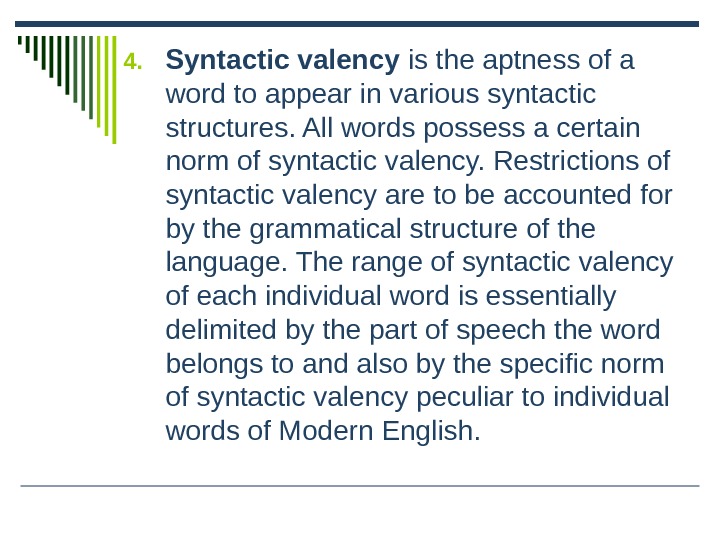

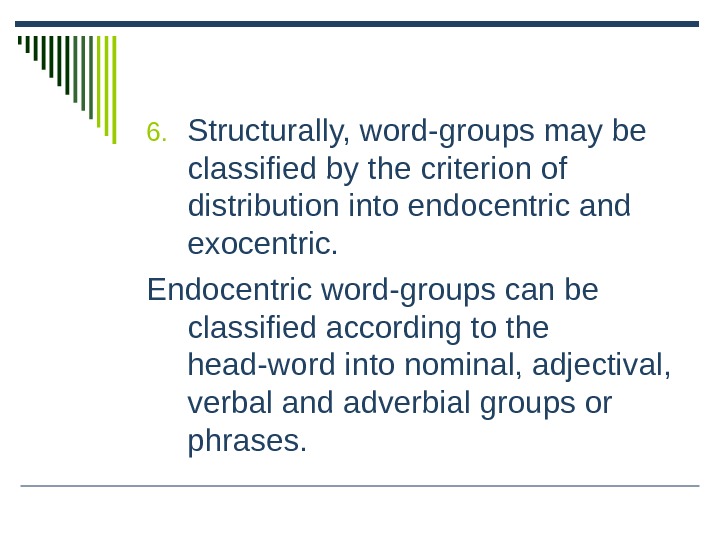
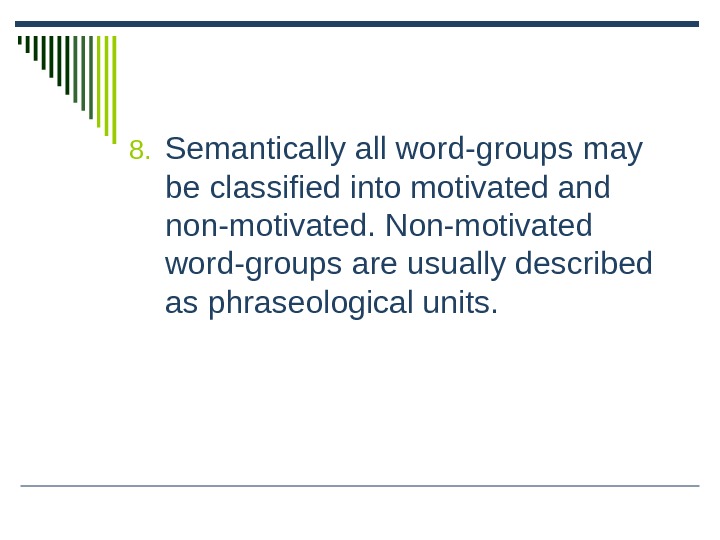


Скачать материал

Скачать материал




- Сейчас обучается 396 человек из 63 регионов




Описание презентации по отдельным слайдам:
-
1 слайд
Word Groups and Phraseological Units
Words put together to form lexical units make up phrases or word-groups.
-
2 слайд
The main factors active in bringing words together are lexical and grammatical valency of the components of word-groups.
-
3 слайд
Lexical valency is the aptness of a word to appear in various collocations.
All the words of the language possess a certain norm of lexical valency.
-
4 слайд
Grammatical valency is the aptness of a word to appear in various grammatical structures.
Restrictions of grammatical valency are to be accounted for by the grammatical structure of the language.
-
5 слайд
Semantically all word-groups may be classified into motivated and non-motivated. Non-motivated word-groups are usually described as phraseological units.
-
6 слайд
The same as words phraseological units express a single notion and are used in a sentence as one part of it.
American and British lexicographers call such units «idioms».
-
7 слайд
Phraseological Units
The border-line between free or variable word-groups and phraseological units is not clearly definedthe existing terms are: set-phrases, idioms, word-equivalents
-
8 слайд
Phraseological units are habitually defined as non-motivated word-groups that cannot be freely made up in speech but are reproduced as ready-made units
-
9 слайд
The main characteristic features of phraseological units are:
— stability of the lexical components
— lack of motivationCOMPARE: red flower and red tape
-
10 слайд
Phraseological units can be classified according to the ways they are formed, according to the degree of the motivation of their meaning, according to their structure and according to their part-of-speech meaning.
-
11 слайд
A.V. Koonin classified phraseological units according to the way they are formed.
He pointed out primary and secondary ways of forming phraseological units.
Primary ways of forming phraseological units are those when a unit is formed on the basis of a free word-group :
-
12 слайд
1) transferring the meaning of terminological word-groups:
«launching pad» in its terminological meaning is «стартовая площадка» , in its transferred meaning — «отправной пункт»,
«to link up» — «cтыковаться, стыковать космические корабли» in its tranformed meaning it means -«знакомиться»; -
13 слайд
2) from free word groups by transforming their meaning,
e.g. «granny farm» — «пансионат для престарелых»,
«Troyan horse» — «компьюторная программа, преднамеренно составленная для повреждения компьютера»; -
14 слайд
3) phraseological units can be formed by means of alliteration ,
e.g. «a sad sack» — «несчастный случай»,
«culture vulture» — «человек, интересующийся искусством»,
«fudge and nudge» — «уклончивость». -
15 слайд
4) they can be formed by means of distorting a word group,
e.g. «odds and ends» was formed from «odd ends», -
16 слайд
5) they can be formed when we use some unreal image,
e.g. «to have butterflies in the stomach» — «испытывать волнение»,
«to have green fingers» — »преуспевать как садовод-любитель -
17 слайд
Other ways:
when a phraseological unit is formed on the basis of another phraseological unit; they are:1) conversion, e.g. «to vote with one’s feet» was converted into «vote with one’s f eet»;
-
18 слайд
2) changing the grammar form, e.g. «Make hay while the sun shines» is transferred into a verbal phrase — «to make hay while the sun shines»
-
19 слайд
3)analogy,
e.g. «Curiosity killed the cat» was transferred into «Care killed the cat» -
20 слайд
4) contrast,
e.g. «cold surgery» — «a planned before operation» was formed by contrasting it with «acute surgery»,
«thin cat» — «a poor person» was formed by contrasting it with «fat cat»; -
21 слайд
6) shortening of proverbs or sayings
e.g. from the proverb «You can’t make a silk purse out of a sow’s ear» by means of clipping the middle of it the phraseological unit «to make a sow’s ear» was formed with the meaning «ошибаться -
22 слайд
7)borrowing phraseological units from other languages
e.g. « living space» (German), « to take the bull by the horns» ( Latin) -
23 слайд
Phraseological units sematically are classified according to V.V. Vinogradov :
-phraseological fusions (сращения) kick the bucket
phraseological unities (единства) e.g. the last straw, to ride the high horse
phraseological collocations (сочетания) e.g. to take smth for granted, to have a bite -
24 слайд
Structurally:
Verbal: to run for one’s life, to talk through one’s hat, to make a song and dance about smth.
Substantive: dog’s life, white lie, calf love.
Adjectival: high and mighty, brand new, safe and sound.
Adverbial: high and low, by hook or by crook
Interjectional: my God! Good Heavens!
Найдите материал к любому уроку, указав свой предмет (категорию), класс, учебник и тему:
6 209 409 материалов в базе
- Выберите категорию:
- Выберите учебник и тему
- Выберите класс:
-
Тип материала:
-
Все материалы
-
Статьи
-
Научные работы
-
Видеоуроки
-
Презентации
-
Конспекты
-
Тесты
-
Рабочие программы
-
Другие методич. материалы
-
Найти материалы
Другие материалы
- 27.12.2020
- 4744
- 2
- 27.12.2020
- 4946
- 11
- 27.12.2020
- 5785
- 13
- 27.12.2020
- 5022
- 9
- 27.12.2020
- 4057
- 1
- 27.12.2020
- 3882
- 0
- 27.12.2020
- 3905
- 1
- 27.12.2020
- 3300
- 4
Вам будут интересны эти курсы:
-
Курс повышения квалификации «Основы туризма и гостеприимства»
-
Курс повышения квалификации «Организация практики студентов в соответствии с требованиями ФГОС юридических направлений подготовки»
-
Курс профессиональной переподготовки «Организация деятельности помощника-референта руководителя со знанием иностранных языков»
-
Курс профессиональной переподготовки «Корпоративная культура как фактор эффективности современной организации»
-
Курс повышения квалификации «Актуальные вопросы банковской деятельности»
-
Курс профессиональной переподготовки «Уголовно-правовые дисциплины: теория и методика преподавания в образовательной организации»
-
Курс профессиональной переподготовки «Методика организации, руководства и координации музейной деятельности»
-
Курс профессиональной переподготовки «Гостиничный менеджмент: организация управления текущей деятельностью»
-
Курс профессиональной переподготовки «Технический контроль и техническая подготовка сварочного процесса»
-
Курс профессиональной переподготовки «Информационная поддержка бизнес-процессов в организации»
Free word-groups. Definition. Classification.
A word-group is the largest two-facet lexical unit comprising more than one word but expressing one global concept.
The lexical meaning of the word groups is the combined lexical meaning of the component words. The meaning of the word groups is motivated by the meanings of the component members and is supported by the structural pattern. But it’s not a mere sum total of all these meanings! Polysemantic words are used in word groups only in 1 of their meanings. These meanings of the component words in such word groups are mutually interdependent and inseparable (blind man – «a human being unable to see», blind type – «the copy isn’t readable).
Word groups possess not only the lexical meaning, but also the meaning conveyed mainly by the pattern of arrangement of their constituents. The structural pattern of word groups is the carrier of a certain semantic component not necessarily dependent on the actual lexical meaning of its members (school grammar – «grammar which is taught in school», grammar school – «a type of school»). We have to distinguish between the structural meaning of a given type of word groups as such and the lexical meaning of its constituents.
It is often argued that the meaning of word groups is also dependent on some extra-linguistic factors – on the situation in which word groups are habitually used by native speakers.
Words put together to form lexical units make phrases or word-groups. One must recall that lexicology deals with words, word-forming morphemes and word-groups.
The degree of structural and semantic cohesion of word-groups may vary. Some word-groups, e.g. at least, point of view, by means, to take place, etc. seem to be functionally and semantically inseparable. They are usually described as set phrases, word-equivalents or phraseological units and are studied by the branch of lexicology which is known as phraseology. In other word-groups such as to take lessons, kind to people, a week ago, the component-members seem to possess greater semantic and structural independence. Word-groups of this type are defined as free word-groups or phrases and are studied in syntax.
Word-groups are classified according to their syntactical pattern into predicative and non-predicative groups. Such word-groups as he went, Bob walks that have a syntactic structure similar to that of a sentence are termed as predicative, all others are non-predicative ones.
Non-predicative word-groups are divided into subordinative and coordinative depending on the type of syntactic relations between the components. E.g., a red flower, a man of freedom are subordinative non-predicative word-groups, red and freedom being dependent words, while day and night, do and die are coordinative non-predicative word-groups.
The lexical meaning of a word-group may be defined as the combined lexical meaning of the component members. But it should be pointed out, however, that the term «combined lexical meaning» does not imply that the meaning of the word-group is always a simple additive result of all the lexical meanings of the component words. As a rule, the meanings of the component words are mutually dependent and the meaning of the word-group naturally predominates over the lexical meaning of the components. The interdependence is well seen in word-groups made up of polysemantic words. E.g., in the phrases the blind man, the blind type the word blind has different meanings – unable to see and vague.
So we see that polysemantic words are used in word-groups only in one of their meanings.
The term motivation is used to denote the relationship existing between the phonemic or morphemic composition and structural pattern of the word on the one hand and its meaning on the other.
Лекции по лексикологии — файл Word-groups.doc
Доступные файлы (26):
| Affixation and conversion.doc | 30kb. | 27.01.2009 21:35 |  скачать скачать |
| Assimilation of borrowings.doc | 64kb. | 26.02.2009 13:30 |  скачать скачать |
| Basic notions. Categorization naming lexicolization motivation.doc | 69kb. | 26.02.2009 13:30 |  скачать скачать |
| Compounding.doc | 72kb. | 26.02.2009 13:30 |  скачать скачать |
| Derivative structure.doc | 70kb. | 26.02.2009 13:30 |  скачать скачать |
| Dictionaries.doc | 67kb. | 26.02.2009 13:30 |  скачать скачать |
| Etymological doublets and hybrids.doc | 64kb. | 26.02.2009 13:30 |  скачать скачать |
| Etymological doublets.doc | 25kb. | 27.01.2009 21:35 |  скачать скачать |
| Etymological structure of English vocabulary.doc | 63kb. | 26.02.2009 13:30 |  скачать скачать |
| Free word-groups vs PU.doc | 63kb. | 26.02.2009 13:30 |  скачать скачать |
| L. as a science.doc | 77kb. | 26.02.2009 13:30 |  скачать скачать |
| LU.doc | 64kb. | 26.02.2009 13:30 |  скачать скачать |
| Meaning.doc | 66kb. | 26.02.2009 13:30 |  скачать скачать |
| Morphemic structure.doc | 70kb. | 26.02.2009 13:30 |  скачать скачать |
| Polysemy vs homonymy.doc | 64kb. | 26.02.2009 13:30 |  скачать скачать |
| Productivity and activity.doc | 67kb. | 26.02.2009 13:30 |  скачать скачать |
| Synonyms vs antonyms.doc | 66kb. | 26.02.2009 13:30 |  скачать скачать |
| Syntagmatic vs paradigmatic relations.doc | 68kb. | 26.02.2009 13:30 |  скачать скачать |
| Types of borrowings.doc | 88kb. | 26.02.2009 13:30 |  скачать скачать |
| Valence.doc | 64kb. | 26.02.2009 13:30 |  скачать скачать |
| Ways of enrichment.doc | 64kb. | 26.02.2009 13:30 |  скачать скачать |
| Word-formation.doc | 66kb. | 26.02.2009 13:30 |  скачать скачать |
| Word-groups.doc | 67kb. | 26.02.2009 13:30 |  скачать скачать |
| Words vs morphemes.doc | 64kb. | 26.02.2009 13:30 |  скачать скачать |
| Вопросы по лексикологии.doc | 68kb. | 26.02.2009 13:31 |  скачать скачать |
| Лексикология.doc | 178kb. | 26.02.2009 13:31 |  скачать скачать |
Word-groups.doc
The structure and meaning.
1) The structure is shown be a syntactic formula (синтаксическая структура словосочетания). It shows the structure of word-groups by the order of the arrangement of their components indicating them as parts of speech (V+N = te release a prisoner, to run a factory).
2) By using syntactic patterns (синтаксическая модель). They describe the word groups in relation to the head word (to release, to run).
The word-groups have lexical and structural meaning.
Lexical meaning is defined as the combined lexical meaning of the component words. Idiomatic meaning — the total change of the initial combined meaning (to catch smb red-handed)
Structural meaning is conveyed by the pattern of arrangement of its constituents (school grammar — grammar school).
— Predicative — have syntactic structure similar to that of a sentence (the horse has run away)
— Non-predicative: subordinate and coordinate.
Subordinate word-groups — consist of a head-word and words subordinate to it (to release a prisoner). In coordinate word-groups — all elements are equal (brother and sister).
If the word-group is used in the same function as one of its members — endocentric. Exocentric — are those that are used differently from either of its members.
— Lexically motivated — the meaning of a word-group is equal to the combined meaning of its components.
— Lexically non-motivated — the word-groups whose meaning is different from the combined meaning of its components (Hobson’s choice — нет выбора; the horse has run away — motivated, the horse has bolted — non-motivated).
Types of Meaning of Word-Groups
The meaning of word-groups can be divided into: 1) lexical and 2) structural (grammatical) components.
1. The lexical meaning of the word-group may be defined as the combined lexical meaning of the component words. Thus, the lexical meaning of the word-group red flower may be described denotationally as the combined meaning of the words red and flower. However, the term “combined lexical meaning” is not to imply that the meaning of the word-group is a mere additive result of all the lexical meanings of the component members. The lexical meaning of the word-group predominates over the lexical meanings of its constituents.
2. The structural meaningof the word-group is the meaning conveyed mainly by the pattern of arrangement of its constituents. For example, such word-groups as school grammar (школьная грамматика) and grammar school (грамматическая школа) are semantically different because of the difference in the pattern of arrangement of the component words.
Thus, the meaning of the word-group is derived from the combined lexical meanings of its constituents and is inseparable from the meaning of the pattern of their arrangement.
Motivation in Word-Groups
Semantically all word-groups can be classified into motivated and non-motivated.
A word-group is lexically motivated if the combined lexical meaning of the group is deducible from the meanings of its components, e.g. red flower, heavy weight, teach a lesson.
If the combined lexical meaning of a word-group is not deducible from the lexical meaning of its constituent components, such a word-group is lexically non-motivated, e.g. red tape (“official bureaucratic methods”), take place (“occur”).
The degree of motivation can be different. Between the extremes of complete motivation and lack of motivation there are innumerable intermediate cases. For example, the degree of lexical motivation in the nominal group black market is higher than in black death, but lower than in black dress, though none of the groups can be considered completely non-motivated.
Completely non-motivated or partially motivated word-groups are described as phraseological units or idioms.
Free Word-Groups Versus Phraseological Units Versus Words
A phraseological unit can be defined as a reproduced and idiomatic (non-motivated) or partially motivated unit built up according to the model of free word-groups (or sentences) and semantically and syntactically brought into correlation with words. Hence, there is a need for criteria exposing the degree of similarity/difference between phraseological units and free word-groups, phraseological units and words.
Structural Criterion
The structural criterion brings forth pronounced features which on the one hand state a certain structural similarity between phraseological units and free word-combinations at the same time opposing them to single words (a), and on the other hand specify their structural distinctions (b).
(a) A feature proper both to free phrases and phraseological units is the divisibility (раздельнооформленность) of their structure, i.e. they consist of separate structural elements. This fact stands them in opposition to words as structurally integral (цельнооформленные) units. The structural integrity of a word is defined by the presence of a common grammatical form for all constituent elements of this word. For example, the grammatical change in the word shipwreck implies that inflexions are added to both elements of the word simultaneously – ship-wreck-( ), ship-wreck-s, while in the word-group the wreck of a ship each element can change its grammatical form independently from the other – (the) wreck-( ) of the ship-s, (the) wreck-s of (the) ship-s. Like in word-groups, in phraseological units potentially any component may be changed grammatically, but these changes are rather few, limited and occasional and usually serve for a stylistic effect, e.g. Black Maria “a van used by police for bringing suspected criminals to the police station”: the Blackest Maria, Black Marias.
(b) The principle difference between phraseological units and free word-groups manifests itself in the structural invariability of the former. The structural invariability suggests no (or rather limited) substitutions of components. For example, to give somebody the cold shoulder means “to treat smb. coldly, to ignore smb”, but a warm shoulder or a cold elbow makes no sense. There are strict restrictions on the componental extension and grammatical changes of components of phraseological units. The use of the words big, great in a white elephant meaning “an expensive but useless thing” can change or even destroy the meaning of the phraseological unit. In a free word-group all these changes are possible.
Semantic Criterion
The semantic criterion is of great help in stating the semantic difference/similarity between free word-groups and phraseological units (a), and between phraseological units and words (b).
(a) The meaning in phraseological units is created by mutual interaction of elements and conveys a single concept. The actual meaning of a phraseological unit is figurative (transferred) and is opposed to the literal meaning of a word-combination from which it is derived. The transference of the initial word-group can be based on simile, metaphor, metonomy and synecdoche. The degree of transference varies and may affect either the whole unit or only one of its constituents, cf.: to skate on thin ice – “to take risks”; the small hours – “the early hours of the morning”. Besides, in the formation of the semantic structure of phraseological units a cultural components plays a special and very important role. It marks phraseological units as bearers of cultural information based on a unique experience of the nation. For example, the phraseological unit red tape originates in the old custom of Government officials and lawyers tying up (перевязывать) their papers with red tape.
In a free phrase the semantic correlative ties are fundamentally different. The meaning in a word-group is based on the combined meaning of the words constituting its structure. Each element in a word-combination has a much greater semantic independence and stands for a separate concept, e.g. to cut bread, to cut cheese, to eat bread. Every word in a free phrase can form additional syntactic ties with other words outside the expression retaining its individual meaning.
(b) The semantic unity, however, makes phraseological units similar to words. The semantic similarity between the two is proved by the fact that, for instance, kick the bucket whose meaning is understood as a whole and not related to the meaning of individual words can be replaced within context by the word to die, the phraseological unit in a brown study – by the word gloomy.
Syntactic Criterion
The syntactic criterion reveals the close ties between single words and phraseological units as well as free word-groups. Like words (as well as word-combinations) phraseological units may have different syntactic functions in the sentence, e.g. the subject (narrow escape, first night, baker’s dozen), the predicate (to have a good mind, to play Russian roulette), an attribute (high and mighty, as ugly as sin), an adverbial (in full swing, on second thoughts). In accordance with the function they perform in the sentence phraseological units can be classified into: substantive, verbal, adjectival, adverbial, interjectional.
Like free word-groups phraseological units can be divided into coordinative (e.g. free and easy, neck and crop) and subordinative (e.g. a big fish in a little pond, the villain of the piece).
Thus, the characteristic features of phraseological units are: ready-made reproduction, structural divisibility, morphological stability, permanence of lexical composition, semantic unity, syntactic fixity.























